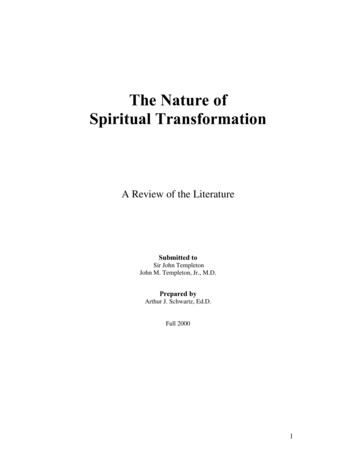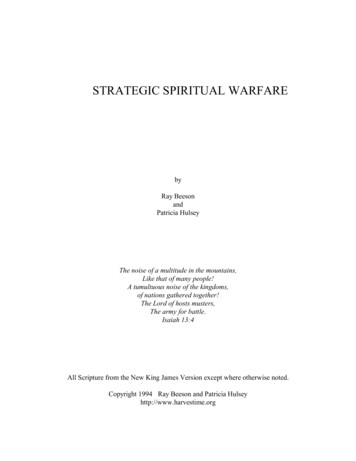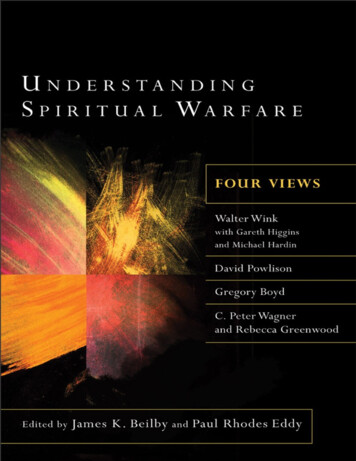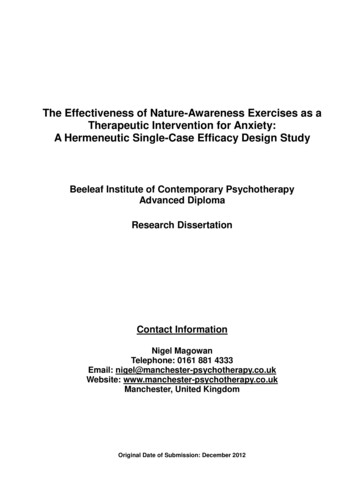
Transcription
The Nature ofSpiritual TransformationA Review of the LiteratureSubmitted toSir John TempletonJohn M. Templeton, Jr., M.D.Prepared byArthur J. Schwartz, Ed.D.Fall 20001
CONTENTSINTRODUCTION. . 3Spiritual transformation as a universal principleThe example of Cassie BernallDEFINING “SPIRITUAL TRANSFORMATION” . . 4Spiritual transformation in the Hebrew ScripturesSpiritual transformation in the New TestamentSpiritual transformation in the KoranWhat distinguishes spiritual transformation from other religious experiencesHow does the term spiritual transformation differ from other similar termsEARLY SCIENTIFIC RESEARCH. . 6The relationship between age and spiritual transformationThe relationship between personality and spiritual transformationThe relationship between stress and spiritual transformationCONTEMPORARY PERSPECTIVES . . 7Six ‘conversion motifs’The “old” versus “new” conversion paradigmRambo’s seven stages of transformationThe “self” and spiritual transformationRECENT SCIENTIFIC RESEARCH . . 10Zinnbauer & Pargament Study (1998)Kirkpatrick Studies (1997, 1998)Kose Study (1996)Miller & D’deBaca Study (1994)Poston Study (1992)Kox Study (1991)Kirkpatrick and Shaver Study (1990)Ullman Study (1989)Paloutzan Study (1981)Turner Study (1979)Heirich Study (1977)Seggar and Kunz Study (1972)REFERENCES. . . 152
INTRODUCTIONThe single purpose of this study is to review the scientific literature on the concept of spiritualtransformation.Learning more about spiritual transformation as a universal principle advances the donor intentof Sir John Templeton. More specifically, Sir John writes in his book Possibilities (2000) that:Christians often refer to a favorite verse in the fourth chapter of the Gospel of John,describing one or more transformative events in their lives as an experience of havingbeen born again. Christians also describe a variety of important experiences as beingfilled with the spirit. Their descriptions often concur in asserting that their lives are nolonger the same and have been transformed for the better. Independent observers oftenattest to these changes as well. Can study of the nature of such changes offer anotherpossibility for developing spiritual progress based on improved understanding of, andappreciation for, spiritually transforming experiences? (p. 112, emphasis added) Spiritual transformation as a universal principleIn addition to exploring spiritual transformation within the context of the Protestant “born again”experience, this study also examines the matrixes of spiritual transformation in other religioustraditions, including Islam, Judaism, and Buddhism. Indeed, one objective of this study is toidentify whether there exists a cluster of universal principles common to all spirituallytransforming experiences, regardless of denomination or a particular religious faith. For asWilliam James once wrote “the god whom science recognizes must be a God of universal lawsexclusively, a god who does wholesale, not a retail business” (1902: 390). The inspiring example of young Cassie BernallPargament (1997) posits that while most of the scientific research and theory in recent years hasfocused on the conservational nature of religion, “religion has the transformative power to createradical personal change.” Perhaps this change can be best exemplified in the life (and tragicdeath) of Cassie Bernall, a Columbine HS teenager whose entire worldview changeddramatically after her “born again” experience. Utilizing the lens of science, this study seeks toexplore the nature of spiritual transformation as experienced by Cassie Bernall and others whohave had similar experiences. Our task is not easy. As Rambo (1993) suggests, it is “difficult tounderstand, predict, and control that which is generally invisible to the outsider, mysterious andsacred to the insider.”3
DEFINING “SPIRITUAL TRANSFORMATION”The appearance of everything was altered; there seemed to be as it were a calm,sweet, cast, or appearance of Divine glory, in almost everything. God’sexcellency, His wisdom, His purity and love seemed to appear in everything: inthe sun, moon, and stars, in the clouds and blue sky; in the grass, flowers, trees;in the water and all nature; which used greatly to fix my mind.- Evangelist Jonathan Edwards, describing his own spiritual transformationFor the purposes of this study, spiritual transformation is defined as a dramatic change inreligious belief, attitude, and behavior that occurs over a relatively short period of time. There isa consensus in the research that this change usually occurs within three contexts:(1) As an intensified devotion within the same religious structure;(2) A shift from no religious commitment to a devout religious life; or,(3) A change from one religion to another.Almost one hundred years ago William James captured the essence of this transformation whenhe wrote: “To say a man is ‘converted’ means that religious ideas, peripheral to hisconsciousness, now take a central place, and that religious aims form the habitual center of hisenergy” (1902:276, emphasis added). Spiritual transformation in the Hebrew ScripturesHistorically, the verb used in the Hebrew Scriptures to denote spiritual transformation wasshubh, which means “to return” or “to repent.” In rabbinic literature a ba’al teshuvah is literally a“master of return” or “master of repentance.” For example, each year at Yom Kippur every Jewis expected to become a ba’al teshuvah, a person who “returns” to God. Interestingly, thecontemporary ‘return’ of secular Jews to Orthodox Judaism has been called the ba’al teshuvahmovement (Klinghoffer, 1999). Spiritual transformation in the New TestamentAlthough the New Testament continues this understanding of spiritual transformation as a“return,” the concept of being “born again” is used prominently to denote a spiritual rebirth intoChrist (John 3:3: ‘No one can see the Kingdom of God unless he is born again’). By the fifthcentury, Saul’s Damascus road experience and St. Augustine’s conversion experience (when heheard the voice of God telling him to pick up the New Testament and read) have become the twoparadigmatic models of Christian conversion. Spiritual transformation in the KoranGod in the Koran also “turns” in mercy and forgiveness toward those who “repent” (taba,meaning to turn) toward him (5:39/45). However, the Koran asserts that God does not “change”(ghayyara) what is in people until they change what is in themselves (13:11/12). This is the4
reverse of the Calvinistic doctrine of ordo salutis, where God, through the Holy Spirit, takes theinitiative to change our hearts. (Woodberry, 1992) What distinguishes spiritual transformation from other religious experiencesSignificantly, contemporary researchers and theologians share the belief that there is no onecause of spiritual transformation, no one process, and no one simple consequence of thatprocess. Moreover, it is usually not a single event, but a complex process that includes acomplex matrix of people, events, institutions, expectations, and experiences. As G.K.Chesterton, once wrote: “The church is a house with a hundred gates; and no two men enter atexactly the same angle. After a comprehensive review of the literature, Hood and his colleagues(1996:276) identified six criteria that distinguish spiritual transformation from other types ofreligious experiences. These are:1.A spiritual transformation is a profound change in the self.2. The change is not simply a matter of maturation, but is typically identified with aprocess (sudden or gradual) by which the transformed self is achieved.3. This change in the self is radical in its consequences – indicated by such things as anew centering of concern, interest, and behaviors.4. This new sense of self is perceived as “higher” or as emancipation from a previousdilemma or predicament.5. This process occurs within a social medium or context, specifically spiritualtransformation entails a religious framework within which the transformed self isdescribed, acts, and is recognized by others.6. Last, if behaviors from these new ideals and changed habits of life do not follow, thenthere has been no transformation.Spiritual transformation is thus understood as a radical reorganization of one’s identity, meaning,and purpose in life. Pargament (1997) suggests that this transformation occurs when anindividual begins to feel connected to a spiritual force, identified as God, Christ, Allah, Buddha.This force, he posits, is not only transcendent but also significant to and shaping one’s immediateexperience. Those who experience a spiritual transformation feel in touch with this sacredspiritual force that changes one’s worldview, range of emotions, and behaviors. Within Christiantheology, the passage in 2 Corinthians 5:17 tells us that this change is indeed a spiritual ‘rebirth’:“The old has passed away, behold, the new has come.” How does the term spiritual transformation different from other similarterms?The term spiritual transformation is used throughout this study to denote what is understoodwidely in the psychology of religion literature as a “conversion experience.” Interestingly, some5
researchers have begun to use the term “quantum change” to highlight the profound nature ofthis religious experience (Miller & C’deBaca: 1994). However, it must be noted that one’sspiritual transformation can be profound whether it occurs gradually or via a “sudden”experience.“Spiritual transformation” will be used instead of a “born again experience” to recognize andhonor the profound and fundamental changes that occur within individuals who have eitherconverted to religious traditions other than Christianity or have intensified their devotion to thesefaiths. Although Judaism, Islam, and Buddhism do not use the term “born again,” these traditionsclearly recognize the reality of spiritually transforming experiences.6
EARLY SCIENTIFIC RESEARCHWhen researching the nature of spiritual transformation it is important for scholars to recognizethat “we stand on the shoulders of giants.” Religious conversion has been a major focus ofscientific psychology since the disciplined emerged at the end of the nineteenth century. Forexample, in 1881, G. Stanley Hall delivered a series of public lectures at Harvard University, anda significant portion of his lectures focused on the phenomenon of religious conversion duringadolescence. Later the material he presented during those lectures, including his theory ofadolescence as a period of “storm and stress,” was incorporated into his classic two-volumestudy titled Adolescence. Relationship between age and spiritual transformationEarly investigators often studied the relationship between age and spiritual transformation.Although spiritual transformation can clearly occur at any age, almost all of these earlyresearchers hypothesized that a religious conversion is more likely to occur during adolescence. Relationship between personality and spiritual transformationUnquestionably, William James set the tone for contemporary empirical work in the psychologyof religious experience. His classic book, The Varieties of Religious Experience (1902), whichemerged out of his Gifford Lectures, partly explored the effects of spiritual transformation onpersonality and behavior. The relationship between stress and spiritual transformationIn addition to James, George Coe (1900) and Edwin Starbuck (1899) conducted empiricalresearch on the experience of spiritual transformation. They concluded independently that thestronger a person’s spiritual background, the greater the chance that the person will reportintense religious experiences and undergo a religious conversion during adolescence or in earlyadulthood. This finding will be discussed in a later section.Most significantly, however, the empirical research of these early pioneers suggested thatspiritual transformation often occurs during and after a period of stress, emotional upheaval,even despair. For example, Starbuck (1899) noted, “the pre-conversion state in adolescentconverts involved a sense of sin, dejection, confusion, and depression which was resolvedthrough conversion.” William James (1902) also noted that in the context of religious conversion“Emotional occasions.are extremely potent in precipitating mental rearrangements.” As weshall see, contemporary researchers continue to examine the function and role of stress as aprecursor or predictor of a spiritual transformation.7
CONTEMPORARY PERSPECTIVESContemporary researchers have focused much of their attention on constructing a variety ofuseful theoretical models (see Hood, 1995). Many of these theorists, mostly psychologists orsociologists, have developed rather sophisticated classification systems or typologies to highlightand demarcate the nature of spiritual transformation. One highly-cited typology, developed byLofland and Skonovd (1981), delineates six conversion “types” or “motifs”: Six “Conversion Motifs”1. INTELLECTUAL: A private, intellectual investigation into a religious faith that results in aspiritual transformation. Generally, the individual experiences little or no externalpressure or influence from “believers.”2. MYSTICAL: This “motif” is marked by high emotional intensity, even trauma at times. ThePauline Damascus road experience is a paradigmatic example of this “motif.” The criticalperiod is often quite brief, although a period of stress may occur days or weeks leadingup to the critical event (in Christianity, this event is often understood as the “born again”experience). Again, this “motif” is generally demarcated by a high level of emotionalarousal followed by an active intensification of belief and religious practice3. EXPERIMENTAL: A very common “motif” in the late twentieth century. People who are“searching” for meaning and divine inspiration frequently “try out” a religion and take ona “show me” attitude. Theology and rituals are explored for meaning and “truth.”4. AFFECTIONAL: The key element in this “motif” is a personal attachment to a practicingbeliever or believers. A personal and emotional relationship with another person or agroup is central to one’s spiritual transformation.5. REVIVALISM: Ecstatic arousal in a group or collective context that has a transforming effecton the individual is the central element of this “motif.” Although Lofland and Skonovdconcede that this “motif” is less prominent in the twentieth century than in the nineteenth,spiritually transforming experiences, especially within the context of evangelicalChristianity, remain common.6. COERCIVE: A relatively rare “motif,” this type includes brainwashing and coercivepersuasion marked by intense pressure on an individual to participate, conform, andconfess.8
Old versus new “conversion” paradigmRichardson (1985) has also studied the characteristics of religious conversion, comparing whathe calls the “old” conversion paradigm and the “contemporary” paradigm. His comparison isoutlined below:Old Conversion ParadigmContemporary Conversion Paradigm1. Conversion occurs suddenly1. Conversion occurs gradually2. It is more emotional than rational2. It is rational rather emotional3. External forces act on a passive agent3. The convert is an active, seeking agent4. There is a dramatic transformation of self4. There is self-realization within ahumanistic tradition5. Behavior change follows from belief changechange5. Belief change follows from behavior6. Conversion occurs once and is permanent6. Conversion is not permanent; it mayoccur several times7. It typically occurs in adolescence7. It typically occurs in early adulthood8. The prototype is Paul’s conversion8. No one experience is prototypical. Rambo’s seven stages of transformationIn one of the most comprehensive analyses of the literature, Rambo (1993) posits a seven-stagemodel to study and identify the process of spiritual transformation. The seven “stages” are:context, crisis, quest, encounter, interaction, commitment, and consequences. Rambo suggeststhat during these processes “relationships, rituals, rhetoric, and roles interact and reinforce oneanother” (p. 101). These four components will be examined in a later section. The “self” and spiritual transformationMuch of the contemporary scientific psychological research examines the relationship betweenthe “self” or personality and spiritual transformation. For example, Paloutzian et al (1999) arguethat spiritual transformation experiences appear to have minimal effect on the “elemental”functions of personality (generally known as the Big Five traits or temperaments, these are:whether one is open to experience, conscientious, extroverted, agreeable, neurotic). However,they suggest that spiritually transforming experiences can result in profound, life changes at themid-level functions of personality -- such as goals, feelings, attitudes, and behaviors. Indeed,these researchers posit that “self-defining” personality functions (such as identity, life meaning)do change dramatically after a spiritual transformation.9
In conclusion, there appears to be consensus among contemporary researchers that: Spiritual transformation influences people’s goals, strivings, and identity Spiritual transformation seems to have little appreciable effect on basic personalitystructure Certain types of personalities may be more prone to spiritual transformation than othersReligious groups may serve as a vehicle for certain types of personalitiesTo a significant degree, future theoretical models and empirical research will be based uponthese findings.10
RECENT SCIENTIFIC RESEARCHAfter conducting a comprehensive review of the literature, Paloutzian, Richardson, and Rambo(1999) inform us that rigorous empirical studies on the nature of spiritual transformation remainscarce. The studies that have been conducted are, with a few notable exceptions, cross-sectional,retrospective, and focus predominantly on Protestant Christianity. Even more problematic,researchers must graft the scientific triad of observation, experimentation, and measurement ontothe reality of spiritually transforming experiences. As Miller and C’deBaca (1994) suggest,scientific inquiry typically starts with systematic observation to describe thephenomena to be understood. Yet prospective access to such occurrences may notbe readily arranged. [Spiritual transformation experiences] as reported inbiographies are often, private, unexpected, even uninvited events. They occur onthe desert road to Damascus, waiting at the front of the library, lying in a hospitalbed, or doing what one has done thousands of times before -- except this time it isdifferent.With this limitation in mind, the following studies represent the most significant examples ofcontemporary empirical research in the area of spiritual transformation and religious conversion: Zinnbauer & Pargament Study (1998)Major finding:Self-definition changed dramatically for both sudden and gradual converts.This study examined the nature of spiritual transformation in a sample of 130 Christian collegestudents. Using a screening questionnaire, students who had experienced a dramatic spiritualtransformation, students whose spirituality had gradually increased, and religious adherents whodid not experience a transformation were selected and a battery of instruments administered. Theresearchers hypothesized that only those who had experienced a spiritual transformation shouldundergo statistically significant personal change. However, they found that self-definitionchanged markedly for both spiritual and gradual converts. Other findings included: those whohad a spiritual transformation reported more pre-conversion stress and perception of personalinadequacy. These students also experienced significant improvement in their personalcompetence after their spiritual transformation. The researchers suggest that their studyreinforces theories that people can and do use religion as a way to accomplish personal growthgoals. Kirkpatrick Studies (1997, 1998)Major Finding:A significant relationship exists between an individual’s “attachment style” andfinding a new relationship with God.Women readers of the Denver Post newspaper were surveyed approximately four years apartabout a variety of religious commitments. The study found that when religion at time T1 was11
statistically controlled, those with an insecure-anxious or an insecure-avoidant adult attachmentstyle were more likely than those with a secure attachment style to report finding a “newrelationship with God” by time T2. In addition, insecure-anxious subjects were more likely thanthose who had secure or ambivalent attachments to report having had a religious experience or areligious conversion during this time period. These initial findings were replicated and extendedin a follow-up study (1998) in which college students were assessed for their attachment stylesand religiousness approximately four months apart. These results were interpreted by Kirkpatrickas supporting the compensation hypothesis in attachment theory. Kose Study (1996)Major Finding:Both cognitive and emotional factors were significant precursors of conversion.This study consisted of interviews with 70 converts to Islam (50 males, 20 females). Themethods used to select the subjects were snowball and convenience sampling. The studyprovided only limited support to earlier studies (e.g., Ullman) that found a significantrelationship between bad or stressful relations with one’s father and conversion. In regard toreligious education, the converts in this study seem to have come from families where there wasno strong identification with any religion. 65 percent of the converts came from families that didnot belong to a church, or were not active participants in a church. The average age when oneconverted is 29.7 years. For most of the converts Kose studied, adolescence was a time whenthey shied away from their childhood religion. Adolescence was not a time when the subjectsexperienced upheaval or trauma, but a time when they rejected the religion of their childhood.Only 11 percent of the 70 reported that they were practicing their religion of origin prior toconversion. Over a quarter (20%) of the sample reported that they were in search of analternative to the secular way of life and wanted to reject the materialistic perspective of society.Emotional and cognitive concerns seem to be equal in characterizing the two-year periodpreceding conversion. 47 percent reported specific concerns that could be designed as cognitiveor existential concerns (e.g., meaning and purpose in life) and 49% reported emotional distressduring the two-year period prior to conversion. Both cognitive and emotional factors seemed tobe precursors of conversion. Finally, the study also demarcated the most motivating factor in thesubject’s conversion process: Emphasis on brotherhood, community, and friendliness (10%);Witnessing life of a Muslim and attraction to the culture (10%); Religious doctrines andteachings (27%); Moral ethical standards, social matters, and political ideology (27%); Spiritual,mystical aspect, or inexplicable religious experience (26%). Miller & C’deBaca Study (1994)Major Finding:Subjects viewed their spiritual transformation as a central turning point, awatershed moment.Subjects were sought via a newspaper feature story in the Albuquerque Journal, asking forvolunteers “who have been transformed in a relatively short period of time – who have had adeep shift in core values, feelings, attitudes or actions.” 52 subjects completed all questionnaires.Subjects viewed their spiritual transformation experiences as central turning points in their lives,watershed moments that divided their memories into before and after. The most common qualityof the effects of spiritual transformation was of liberation, a new kind of meaning and12
perception. A majority of subjects (85%) currently described themselves as either religious(41%) or spiritual (44%). With respect to belief in God, 59% reported having believed in Godbefore their experience, and 83% reporting believing in God now. According to the researchers,the largest immediate shifts were reported as an increase in the “sense of meaning,” a decreasedsense of something missing in life, and increased happiness, satisfaction, and a closeness to God.Finally, the researchers found that men reported that prior to their spiritual transformation, theirfive highest values were (in order): wealth, adventure, achievement, pleasure, and beingrespected. These values were reordered (out of 50) after their spiritual transformations, oftenrapidly, falling to current priority ranks wealth (50), adventure (29), achievement (26), pleasure(25), being respected (33). In their place, new top priorities for men were spirituality, personalpeace, family, God’s will, and honesty. Poston Study (1992)Major Finding:Only 3 of 72 converts to Islam reported an emotional, Pauline-type conversion inwhich mystical or supernatural factors were perceived.A questionnaire study of 72 American and European converts to Islam. 69 percent of the subjectswere male. Most of the converts were raised as Christians. The average conversion age in thisstudy was 31.4 years. For Poston’s subjects, an advocate or a personal relationship with a currentadherent to Islam was the chief motivating factor which the overwhelming majority foundsignificant. 75 percent of the subjects mentioned aspects of the teaching of Islam as beinginstrumental in their decision to convert, while 60 percent mentioned specific individuals orgroups which had influenced them in their decision. Poston’s study also underscores thehypothesis that emotional and crisis-triggered conversions are not common to Islam. Only 3 ofthe 72 converts reported an emotional, Pauline-type conversion in which supernatural factorswere perceived. Kox Study (1991)Major Finding:Converts were more likely than non-converts to report a major life event prior totheir conversion.This study compared a group of young converts to a charismatic Christian denomination to agroup of matched controls. 67% of the converts reported personal problems within 3-5 yearsbefore conversion, as opposed to 20% of the control groups. Converts were also more likely thanthe non-converts to report a major life event prior to their conversion (e.g., a move, the death of aparent, or parents’ divorce), although a significant percentage of converts do not report crisis justprior to their conversion. Kirkpatrick and Shaver Study (1990)Major Finding:The researchers found an association between retrospective accounts of childmother attachment and conversions. In particular, insecure-avoidantattachments were found to predict adolescent and adult sudden conversions.13
Ullman Study (1989)Major Finding:Major issues motivating converts were emotional, involving problematicrelationships with their father, unhappy childhoods, and a past history ofdisrupted, distorted personal relationships.Published in book form under the title The Transformed Self: The Psychology of ReligiousConversion, Ullman’s research is widely cited as one of the few empirical studies that compares“conversion processes” across different religious groups with matched controls. Ullman studied10 converts to Orthodox Judaism, 10 Roman Catholic converts, 10 Hare Krishnas, 10 Bahai, anda group of thirty people who served a matched control group. Her research, utilizing a battery ofinstruments and semi-clinical interviews, compared and contrasted factors such as the amount oftrauma or family conflict in the converts’ lives during childhood and adolescence, their degree ofinterest in religious and existential questions, and their degree of involvement with religiousgroups. Although Ullman initially theorized that the major motivation for conversion was theneed for what she called “cognitive meaning,” she found, in fact, that the major issues motivatingthe forty converts (in comparison to the control group) were emotional, involving problematicrelationships with their father, unhappy childhoods, and a past history of disrupted, distortedpersonal relationships. The major differences between the four converted groups and theconverted group were on emotional, not cognitive, indices. Her core finding, was that theconverts, to a statistically significant level, had absent, weak, or abusive fathers. This seriouspsychological deprivation and abuse appeared to motivate and inform the person’s conversion.Finally, many of the converts established a powerful relationship with a guru, rabbi, priest, orother person in the group to which they were converted and these relationships were absolutelycentral during the conversion process. Paloutzian Study (1981)Major Finding:Study confirmed the hypothesis that converts perceive more meaning in life thannon-converts.This study examined the changes in purpose in life over time following religious conversion. Thesubjects were 91 students in a large psychology course; 51 experimental subjects were those whoindicated that they were Christian believers and 40 were control subjects. The questionnaireconsisted of the Purpose in Life Test, the Rokeach Values Survey test, and items to determine theamount of time since one’s conversion. The study confirmed the hypothesis that convertsperceive more meaning in life than non-converts. Turner Study (1979)Major Finding:As a result of mass conversions to Protestant Christianity in Chiapas, Mexico,the researcher documented lower levels of po
in the water and all nature; which used greatly to fix my mind. - Evangelist Jonathan Edwards, describing his own spiritual transformation For the purposes of this study, spiritual t










